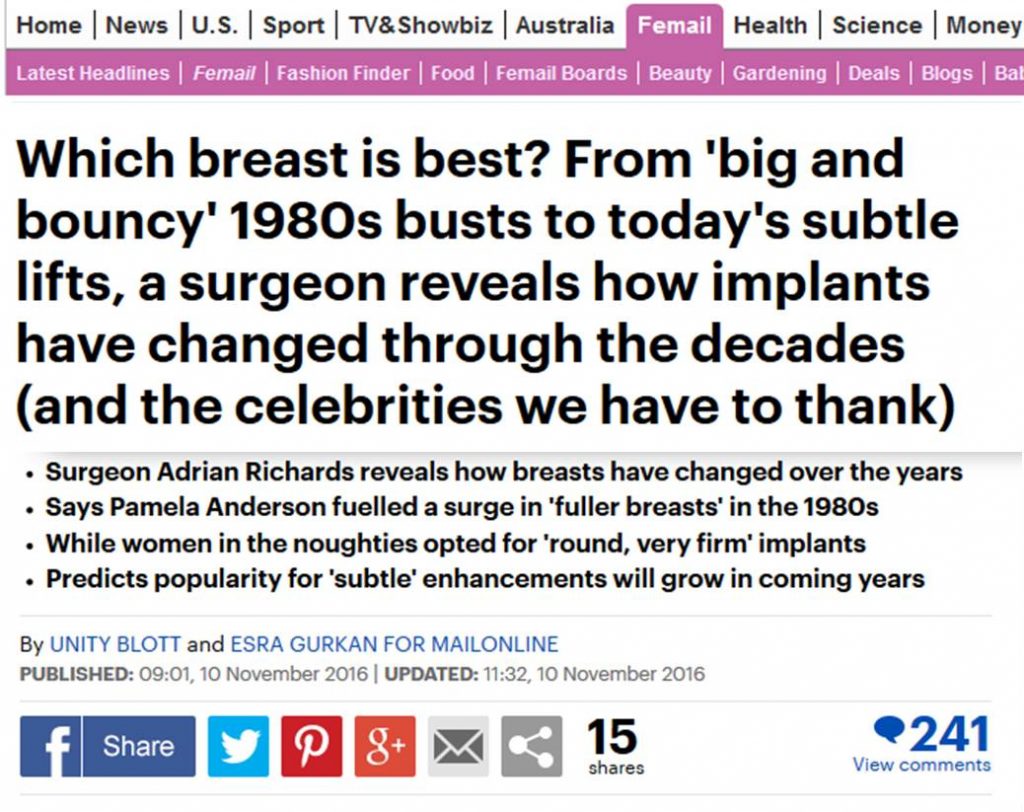
Which breast is best?
PLASTIC AND COSMETIC SURGERY
The Daily Mail
From ‘big and bouncy’ 1980s busts to today’s subtle lifts, a surgeon reveals how implants have changed through the decades (and the celebrities we have to thank)
- Surgeon Adrian Richards reveals how breasts have changed over the years
- Says Pamela Anderson fuelled a surge in ‘fuller breasts’ in the 1980s
- While women in the noughties opted for ’round, very firm’ implants
- Predicts popularity for ‘subtle’ enhancements will grow in coming years
From over-sized implants to subtle lifts, there have been major changes to the size and shape of the ‘perfect’ bust over the years.
Each decade brings with it a new aesthetic – and women are happy to spend serious money to achieve the ‘right’ look.
Adrian Richards, consultant plastic surgeon at The Private Clinic of Harley Street, talked FEMAIL through the key trends over past 40 years – and the celebrities who helped to make them marketable.
The 1980s
‘In 1980s, we witnessed demand for larger implants grow,’ says Mr Richards. ‘Interest in bigger, fuller breasts was perhaps most notable in the US, where celebrity icons like Pamela Anderson and Carmen Electra helped fuel the trend.
‘When we look back at TV shows and films from the 1980s, we can see that a lot of iconic female stars showcased large, round breasts on tiny frames. In the UK during this time, however, the demand for larger breasts was less noticeable, and women who sought implants remained more interested in moderately sized implants.’
The 1990s
‘Demand for bigger, fuller breasts grew even more into the 1990s,’ Adrian explains. ‘In fact, this decade saw more and more women showcasing an interest in even larger sized implants. Bigger, bolder breasts were ‘in’, with the likes of Katie Price (Jordan) sporting a more augmented look.
‘In the UK women sought large, round, firm implants, and tended to opt to have these put in front of the muscle. This allowed the outline of the implant to be seen through the skin, particularly if the patient was very lean.
‘Unlike during the 1980s, by the 1990s breast implants were no longer something only the rich and famous invested in. More and more women up and down the country began to consider the possibility of an enhancement.’
The 2000s
‘The passing of the millennium marked the end of an era for larger-than-life breast implants. A slightly smaller, yet pneumatic look began to take centre stage instead. This trend was perfectly embodied by Victoria Beckham, whose DD implants appeared to sit impossibly high on her chest.
‘At this time patients demanded round, very firm implants, placed under the muscle. This form of implant, when chosen by a very slim woman, was easy to notice.
‘However, slim women who opted for implants that were too big for their bodies would likely go on to suffer with stretching and thinning of the skin, largely because of the size and firmness of the implant.
The 2010s
‘Today, when we consider trends in breast augmentation, it’s clear that bigger is no longer always necessarily better. Now, what we call low profile implants are some of the most popular amongst women in the UK.
‘Low profile implants are flatter, more subtle and offer a natural enhancement, which could perhaps go undetected should the patient prefer them to. If we look at Taylor Swift – who I believe has had implants – we can see that her breasts appear slightly larger than several years ago but yet they are not overly enhanced, nor do they sit too far out on her chest.
‘Taylor has a ‘gazelle’ like shape – she is tall and lean. So for her, lower profile implants are more appropriate because they offer a natural looking lift, which suits her. This implant is in proportion to her body.
‘Today I see more and more patients requesting this form of implant. No longer do women want implants which are hugely visible and very large – it’s all about a natural, subtle enhancement.
‘Patients who opt for implants which are too big for their frame are also likely to go on to have difficulties in the long term. Most people have a “footprint” to the breast [the outline of the breast base on the chest wall].
‘If you go too big, the implant always comes sideways outside of the arm and can damage the breast tissue. This is a very common reason why some women go on to have breast reductions later down the line.
‘Overall, trends will come and go, but the most important thing to remember is that the size, shape and placement of the breast implants chosen should fit the patient and be in proportion to their body.
‘As time goes on, I expect to see the trend for subtle, natural implants grow as women opt for enhancements which suit their body shape and still allow them to feel natural.’





